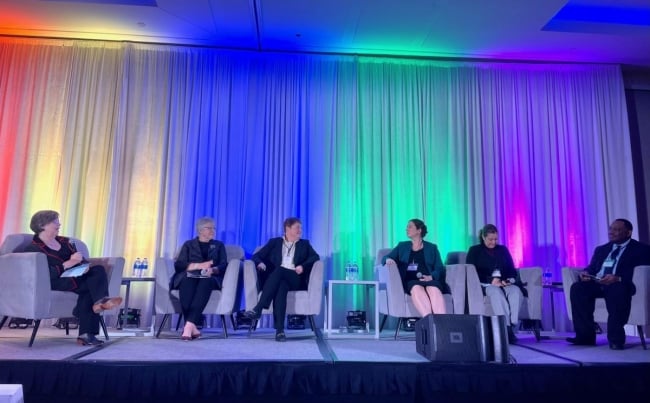You have /5 articles left.
Sign up for a free account or log in.

A panel of higher education leaders discusses the beginnings of the Power of Systems.
Emma Whitford/Inside Higher Ed
The National Association of System Heads and more than 100 higher education leaders convened this week to launch the Power of Systems—a national initiative that calls on a network of public university systems to address several pressing issues in higher education.
The initiative will aim to improve credential completion and social mobility and to reduce student debt by tackling issues and inefficiencies in five key areas of higher education: learning, talent, equity, investment and “systemness,” or the practice of fostering cohesion over competition among different systems.
The two-day launch event was full of energy and big ideas but short on details. It’s unclear exactly how NASH and its network of university systems will pull off their equity, student success and investment goals, but that information is forthcoming, according to Nancy Zimpher, senior fellow at NASH and co-coordinator of the Power of Systems. First, systems across the country need to buy in to the plan.
“We would like to know, for starters, ‘Is this an idea that you think it’s time for?’” Zimpher told Inside Higher Ed. Systems don’t have to “promise or [commit] that you have to do an exact thing. But you will pick up the phone. You will tune in to Zoom and further this conversation.”
Formed in 1979, NASH currently includes 42 public systems within 29 states. The association is working to recruit another 20 systems. NASH has focused on improving student success and closing equity gaps for years, but the Power of Systems initiative broadens the association’s goals.
Throughout the event, Zimpher and Rebecca Martin, executive director of NASH, emphasized systemness, which they define as moving beyond competition across systems and prioritizing integrated services, resource sharing and the exchange of ideas.
“The whole is greater than the sum of the parts,” Zimpher said during her speech Wednesday.
One example of successful systemness, she noted, emerged when public university systems came together to respond quickly to the COVID-19 pandemic. Dozens of colleges and universities shared strategies for online learning and helped each other develop contact tracing and testing protocols for their campuses.
The new initiative “was born in the crisis of that moment,” Zimpher said. Systems “had a special role to play. This is the fastest we’ve ever turned anything around—we literally turned residential to remote in two weeks.”
During the conference’s launch event, leaders met to discuss ideas for tackling the five problem areas the Power of Systems identifies. Sharing student information systems, for instance, would reduce administrative burden and expenses, panelists suggested. James Kvaal, U.S. under secretary of education and keynote speaker at the event, highlighted how long it takes to make changes to the Integrated Postsecondary Education Data System—the federal government’s higher education data hub. More robust data on race and ethnicity could also help further institutions’ equity goals, according to some panelists.
Participants also discussed a potential learner pathway profile, which would help bridge the gap between college and industry by building talent profiles for students. Employers could use the profiles to identify potential hires, and students could use them to advertise their skill sets and experience.
Miguel Cardona, U.S. secretary of education, could not attend the event, but he published a message of support for the initiative.
“I am heartened that the transformation of public higher education systems across the country is underway. This is a very important moment for the country, for the future of higher education, and for the public will to improve the condition of our lives for generations to come,” Cardona wrote in his message.
Investment is also imperative to the Power of Systems’ success—not just in systems more generally, but in the initiative itself. About a dozen companies and higher education nonprofits—including TIAA, the Carnegie Corporation of New York, the Lumina Foundation and Strada Education Network—will underwrite the initiative for about 10 years. The group is asking for philanthropic support “in the millions” but hopes to eventually lean on public and state funding, Zimpher said.
“We need every system participating,” Zimpher said. “That’s what will make believers out of our investors.”








